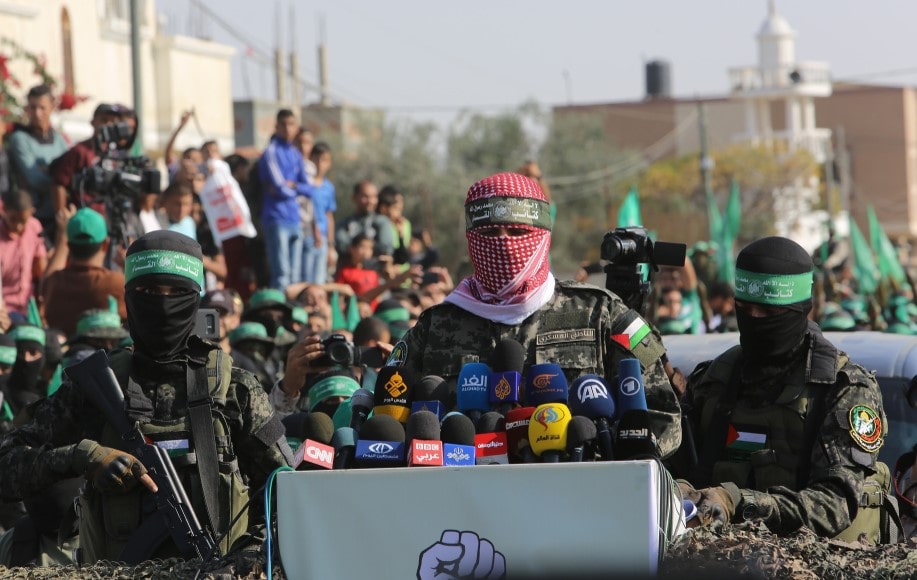
Terror groups, like human beings, have a life cycle. They grow, mature, and eventually die. Often, they morph into something that is not quite what they envisioned in their early years. Palestinian terrorists are not immune to this process, as Hamas is finding out these days.
Terrorist organizations tend to be wild and reckless in their youth. Infused with energy and enthusiasm, they cling to lofty ideals and set out to change the world around them. But this phase does not last forever.
Over time, terrorists face intensifying pressure from governments and security agencies. Internally, they often struggle to maintain unity and a commitment to a single vision. Field operatives and commanders die; new recruits come and go. Ultimately, most groups never make it to old age.
The trouble often starts around the 30th anniversary. This could be a period of great uncertainty and confusion, for individuals and terror groups alike. It is a time to reassess what was achieved so far, and what lies ahead. Are we moving in the right direction? Will we ever achieve success? Such questions can prompt some big changes.
The Fatah Case Study
Before considering Hamas, it is useful to look at the group’s chief rival in the Palestinian arena, Fatah. The movement was founded in 1959 with the aim of replacing Israel with a Palestinian state through armed struggle.
Fatah and its offshoots proceeded to target soldiers and civilians in Israel and abroad. The group’s terrorists attacked Israeli planes and Olympic athletes, planted bombs, and staged murderous raids into Israeli communities.
The tactics and names kept changing, but the focus on armed “resistance” to Israel remained constant. And then the movement hit 30.
Notably, Fatah faced some setbacks even before turning 30. In the early 1970s, Jordan’s king forcibly ejected the movement from the country. In 1982, Fatah lost its stronghold in Lebanon after Israel invaded and sent Yasser Arafat and his cronies into exile in Tunisia.
But the process of change took some years to materialize. It always does. By the early 1990s, Fatah increasingly came to consider a negotiated settlement with Israel. Regardless of whether the group saw this as a ploy to eventually eliminate the Jewish State, something fundamental had shifted.
In 1993, Fatah marked its 34th anniversary. That year, it signed a peace treaty with Israel.
Aging Terrorists
The Oslo Accords did not end Fatah terror immediately. Such groups cannot change overnight. It cooperated with Israel for some time, only to take up arms again less than a decade later. However, the Second Intifada and its disastrous outcome accelerated the change.
Arafat’s successor, Mahmoud Abbas, is no fan of Israel. But he is also no fan of the armed struggle, having realized its futility. For more than 15 years, Abbas has cooperated with Israel, even if reluctantly, in curbing terror. Under his leadership, Fatah no longer carries out attacks.
Fatah could still resort to terrorism or other forms of violence, but the group will never quite be the same. It is now descending into its twilight years, as its surviving leaders approach the end of their life.
Fatah’s political manifestation, the Palestinian Authority, will likely not last long. The young generation is already alienated from the old and decaying movement. Sooner or later, new forces will emerge on the front lines of the battlefield.
The Gaza Trap
For Hamas, the confusion started in 2007 when it took over Gaza. Suddenly, the group was in charge of administering the Strip and caring for the needs of a large civilian population. This put Hamas well beyond its comfort zone.
Terror groups are mostly focused on carrying out violent attacks against their foes. They are far less interested in dealing with matters pertaining to sewage and garbage disposal. Moreover, terrorists prefer to divert their resources to the armed struggle, not to civilian needs.
The new duality of purpose left Hamas in a constant state of imbalance. On top of this, the group was now responsible for any violence originating from Gaza, even when carried out by other factions.
Hamas continued to fight Israel with rockets and other weapons, but the pressure started to take its toll. The group increasingly took a “pragmatic” approach, which resulted in a decline in terror attacks and periodic lulls in violence.
In order to avoid punitive strikes by Israel, Hamas also started to enforce a truce on other factions. In essence, the group was preventing rocket attacks on Israeli communities. Clearly, this is an awkward position for an organization committed to destroying the Jewish State.
Hamas Seeks Truce
The weekly border protests Hamas initiated in 2018 were meant to reassert its militant credentials. By sending youngsters to clash with soldiers, Hamas signaled that it was still committed to the struggle with Israel, while using low-intensity violence to limit the Israeli response.
Regardless of the efforts, observers continued to notice that Hamas was barely fighting any more. Something fundamental was gradually changing.
This year, Hamas marked its 32nd anniversary. Coincidentally or not, it is now engaged in talks on a long-term ceasefire with Israel. Arab affairs commentator Zvi Yehezkeli says that the group faces an excruciating dilemma. If it signs a deal, it will no longer be Hamas that we know.
However, the very willingness of Hamas to even consider such truce is telling. It may take a few more years, but Gaza’s rulers seem to be headed on the same path that many other terrorists took before.
For now, Hamas remains a mortal enemy of Israel. But where will the group be in 10 or 20 years? Midlife crisis is fast approaching, and is certain to bring more changes, as the life cycle of terror runs its course.


